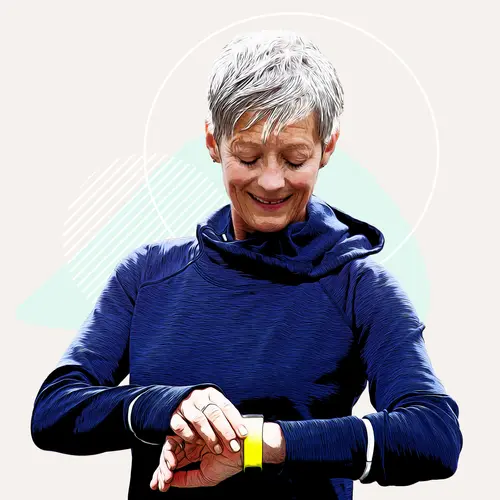Joint pain and stiffness seem to go hand in hand with aging, not just old age. Starting around age 30, you begin to lose bone density and muscle mass, both of which can create strain and pain in your joints.
Robin Jahrous of Lake Bluff, IL, certainly felt that strain and pain as a young adult. She was diagnosed with knee osteoarthritis (OA) in her 30s. This type of arthritis, sometimes called “wear and tear” arthritis, happens when the cartilage that protects the ends of your joints wears down. As the years wore on, her joints continued to wear down. In 2010, when Robin was 55, she had a knee replacement.
“Most people will develop some degree of osteoarthritis. That is what usually causes joint aches and pains as people get older,” says Keith Roach, MD, an associate attending physician at NewYork-Presbyterian Hospital and an associate professor of clinical medicine at Weill Cornell Medical College.
However, he says people who see him for new joint pain don’t always have OA. Sometimes there’s an obvious injury. Sometimes, it might be another disease.
Common Causes of Stiff Joints
More than 32.5 million adults have OA-related joint pain, aching, stiffness, or limited mobility. But you can have stiff joints without OA. In fact, you can have stiff joints without any clear cause.
Blame it on getting older. The connective tissue in your tendons and ligaments gets stiffer as you age. Also, loss of muscle strength as you age can increase pressure on your joints, especially your knees. Roach says the pain you feel is likely the start of OA, which commonly starts in your 50s and usually affects women more than men. You’ll want a doctor to check it out instead of only self-treating symptoms at home. That way you can get some personalized advice on how to maximize your joint health. Plus, it is important to know if the pain is instead caused by something serious like an autoimmune disease.
Inflammatory Arthritis in Older Adults
If you’re well into middle age or past it, your doctor may consider a handful of conditions that aren’t due to mechanical stresses: the pounding, twisting, and pulling our joints endure countless times a day.
“Other causes of intra-articular pain, which is pain inside the joint as opposed to the tissues around it, can be broadly characterized as inflammatory conditions,” says Ruchi Jain, MD, a rheumatologist at Magnolia Rheumatology in Westchester County, New York.
There are many inflammatory joint conditions -- essentially inflammatory arthritis -- but they all have one thing in common: an overactive immune system. Unlike OA, they aren’t usually associated with aging. But some inflammatory conditions do have a big impact on an older population.
“Pseudogout commonly affects wrists and knee joints in patients above the age of 65. Your doctor may also look at the possibility of elderly-onset rheumatoid arthritis or psoriatic arthritis,” Jain says.
Another diagnosis that may be considered is polymyalgia rheumatica, or PMR. “It typically causes sore, stiff shoulders and hips, and sometimes systemic features such as fatigue and low fevers,” Jain says.
Non-arthritis Pain
Arthritis is so commonly linked to aging joints that you may not even consider the possibility of another cause. Your doctor will though, which is why it’s important to make an appointment instead of self-treating your nagging pain.
Jain has seen a wide spectrum of joint problems. She says the major causes of joint pain outside of arthritis include:
- Joint-related injury (such as strained ligaments and tendons)
- Bone pain from fractures
- Lack of vitamin D
- Hypothyroidism, or an underactive thyroid gland
How to Protect Aging Joints
You may be able to reduce your risk of joint pain and injuries as you age by making smart choices. For example, warm up before exercise and stop if you feel new or worsening pain. It’s more challenging to reduce your risk of joint diseases, though not impossible.
To keep your joints as healthy as possible into your golden years, follow these general tips to reduce pain and maintain function:
Treatment for Stiff, Painful Joints
Treatment for painful or stiff joints depends entirely on the cause of your pain. For OA, your doctor may suggest one or more of these treatments recommended by the American College of Rheumatology:
- Acetaminophen
- Nonsteroidal anti-inflammatory drugs (NSAIDs) in pills or spread on your skin
- Some opioid pain relievers, but only for a short time
- Joint injections (often corticosteroid shots)
- Aerobic, aquatic, or resistance exercises
- Weight loss
- Special insoles for different types of knee OA
- Physical therapy
- Tai chi
Inflammatory conditions require a different treatment approach. You’ll want to treat the symptoms as well as the disease. Your doctor will work with you on a customized treatment plan, but in general it will focus on these areas:
- Medications to manage the disease
- Sometimes, medications to manage the side effects
- A diet that promotes healthy weight and reduces inflammation
- Regular, low-impact physical activity
- Stress management
- Symptom tracking to help your doctor know if the plan is working


